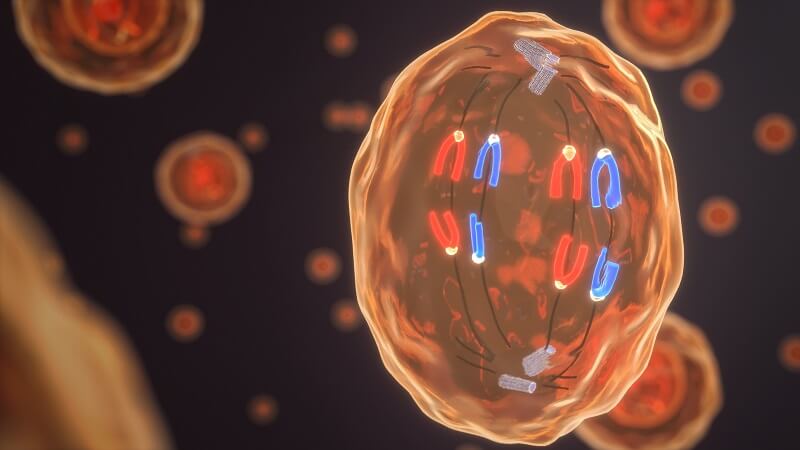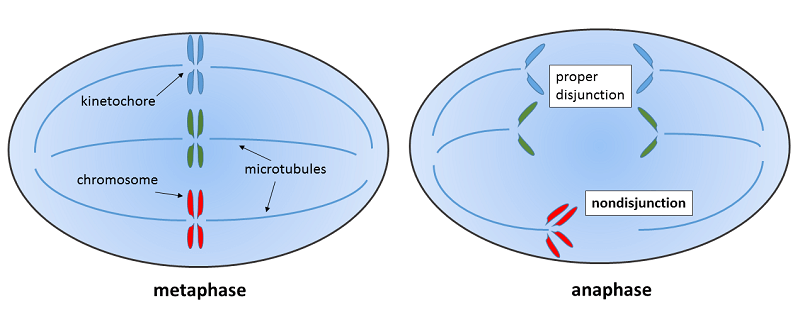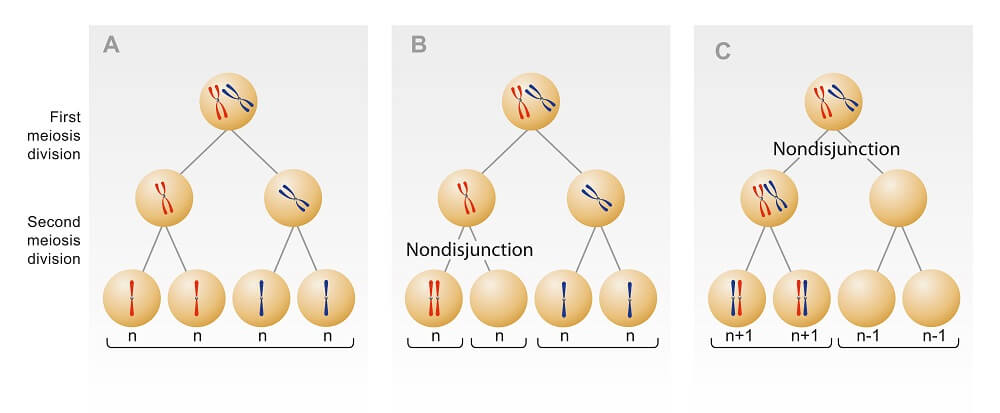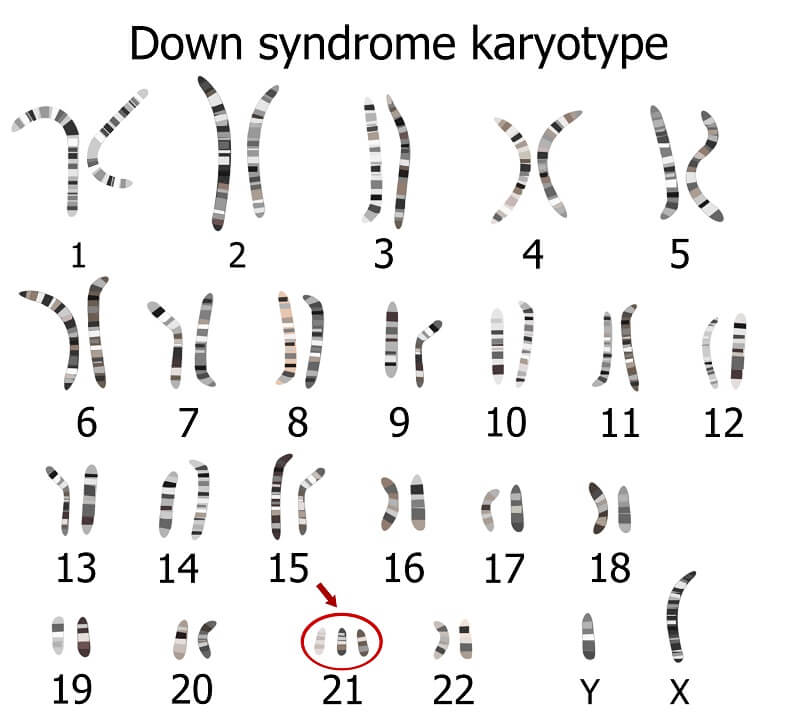Definition
Nondisjunction occurs when chromosomes do not separate properly during cell division. This produces cells with imbalanced chromosome numbers.
Chromosomes contain the cell’s DNA, which is crucial for its functions and reproduction. Normally, when a cell divides, the chromosomes line up in an orderly fashion at the centre of the cell. Then, when the cell divides into two, the chromosomes are separated into each new cell.
When these chromosomes fail to separate properly, nondisjunction has occurred. The resulting daughter cells have an incorrect number of chromosomes; one may have too many, while another may have too few. This causes problems in cell function because a cell cannot function normally without the correct chromosome complement

Types of Nondisjunction
Nondisjunction can occur during mitosis, meiosis I, or meiosis II.
Nondisjunction During Mitosis
Somatic cells, or cells of the body, divide in order to repair, grow, and maintain tissues. They do so through replicating their DNA and redistributing it to new cells through the process of mitosis. From each original parent cell, two identical daughter cells are produced.
After DNA replication in the parent cell, each chromosome is composed of two identical sister chromatids. During the anaphase stage of mitosis, these chromatids separate, and one chromatid goes into each daughter cell.
However, when nondisjunction occurs, the chromatids do not separate. The result is that one cell receives both chromatids, while the other cell receives neither. Each daughter cell then has an abnormal number of chromosomes when mitosis is complete; one cell has an extra chromosome, while the other is missing one.

Nondisjunction During Meiosis I
Gametes (eggs and sperm) are made through a specialized type of cell division called meiosis. Two produce the gametes, one parental cell replicates its DNA and divides into four daughter cells through two rounds of meiosis. The resulting cells are haploid; they contain half the amount of DNA as a somatic, or body cell.
The first round of meiosis, called meiosis I, is similar to mitosis. However, in meiosis I, the chromosomes pair up with one another before separation into two cells, for making gametes, whereas, in mitosis, the chromosomes are all in one line ready to be separated into two identical cells.
Nondisjunction happens during anaphase, when a pair of homologous chromosomes do not separate before being distributed into two daughter cells. In the resulting cells, one cell has two copies of a chromosome, while the other cell has no copies. When each of these cells goes on to divide into two cells during meiosis II, the four total cells produced will all have chromosomal abnormalities.
Nondisjunction During Meiosis II
Even if a cell divides normally in meiosis I, nondisjunction can still occur in the second round of meiosis, meiosis II. During meiosis II, each of the two daughter cells produced during meiosis I undergo a second round of meiosis, going from diploid (two pairs of each chromosome) to haploid (one of each chromosome). This allows them to participate in sexual reproduction; once the egg and sperm combine during fertilization, the diploid state is restored.
If a pair of sister chromatids fail to separate properly during anaphase of meiosis II, one daughter cell will have an extra chromosome and one daughter cell will be missing a chromosome. If the other daughter cell created in meiosis I splits properly, the other two of the four total daughter cells created during meiosis II will have the normal number of chromosomes.
Thus, the effects of nondisjunction during meiosis are observed only in the offspring of the individual. The effects of non-disjunction during mitosis are only observed in that individual and are not passed on to the next generation.

Examples of Nondisjunction Disorders
Cancer
When nondisjunction occurs in somatic cells, the cell systems can detect that something has gone awry, and cause that cell to undergo apoptosis (cell suicide).
However, if nondisjunction goes undetected, it can contribute to the development of cancer. This is because imbalances in the expression of the genes in the chromosomes can lead to abnormal cell phenotypes, and can cause unchecked cell proliferation. Unregulated cell division is a hallmark of cancer.
Extra copies of chromosomes are frequently found in haematopoietic cancers (blood cancers) and invasive breast cancers.
Down Syndrome
Down syndrome occurs as a result of maternal nondisjunction during meiosis I. It produces an egg cell with an extra copy of chromosome 21. That means, that the resulting embryo has three copies of chromosome 21, two from the mother, and one from the father. This is called a trisomy. People with Down syndrome have three copies of chromosome 21 in all of their somatic cells.
The extra chromosome in the cells of those with Down syndrome is responsible for a host of characteristics, including delays in physical growth, certain facial features, and mild intellectual disability. Rates of nondisjunction in the gametes increase with age, which is why older mothers have a higher chance of giving birth to a child with Down syndrome. According to the Mayo Clinic, this chance drastically increases between the ages of 35 and 45, going from 1 in 350 at 35 years to 1 in 30 at 45 years.

Sex Chromosome Aneuploidy
Sex chromosome aneuploidy is the term for an abnormal number of sex chromosomes. Normally, females have two X chromosomes, while males have one X and one Y. Nondisjunction can cause individuals to be born female with one X (Turner syndrome), female with three X chromosomes (Trisomy X), male with XXY (Klinefelter syndrome), or male with XYY (XYY syndrome). Rarer combinations, such as having five X chromosomes, can also occur. Sometimes, sex chromosome aneuploidy goes unnoticed in individuals, but other times it may present as a recognizable syndrome with characteristics such as intellectual disability.
Other Types of Trisomy
Most cases of trisomy result in miscarriage during the first trimester of pregnancy because the fetus cannot survive the chromosomal abnormality. Trisomy 16 occurs in over 1% of pregnancies and is the most common trisomy, but most individuals with this trisomy do not survive unless some of their cells are normal.
The three most common types of trisomy that are survivable are Trisomy 21 (Down syndrome), Trisomy 18 (Edwards syndrome), and Trisomy 13 (Patau syndrome).
The reason these chromosomal abnormalities are more common is due to the specific chromosomes they affect. Chromosome 21, 18, and 13 are all relatively small and gene-poor; they don’t have as many genes on them as other chromosomes. This means they have less of a drastic effect on the cell. As a result, more individuals survive with these trisomies. Others are non-viable.
Quiz
